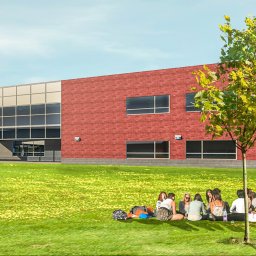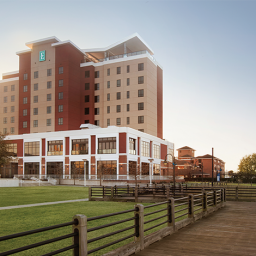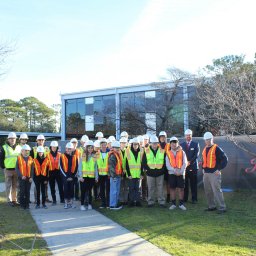Shifts in the way people work, communicate and learn have led to changes in the way spaces are designed, built and used. Understanding this evolving landscape can help business leaders better serve employees and optimize their performance.
W.M. Jordan Company’s Wilmington, N.C. office has six times the number of employees than when we started just six short years ago. Finding the right talent and facilitating their growth and development is essential to our continuing regional success.
To accommodate our growing work tribe, the office has undergone two expansions and multiple improvements. While a good work environment always starts with hiring the right people, considering a few fundamental building and design principles may help you foster a more productive workplace.
Understand The Value Of Employee Engagement
The more efficient your employees are, the more successful you will be as a business. According to a study by Gallup, teams with high employee engagement rates are 21 percent more productive than those with low engagement.
In contrast, the same study revealed over half of the U.S. workforce is not engaged. Just as employees are expected to perform, mangers and company execs should have a sense of responsibility for the engagement of their staff.
While this can be challenging and requires commitment, the value that engaged employees adds to your organization is exponential.
Empathy For The End-User
An empathetic approach is used across many industries, including construction, to improve outcomes. W.M. Jordan Company is the Construction Manager for the Town Creek Middle School project in Brunswick County. As the project began, the design team led a series of participatory style public meetings and design strategy sessions to engage end-users in dialogue. This exercise allowed the design team, contractor and school system to gain insight from teachers, parents, educators and the community about what was important. Challenges, the use of physical space and budgetary constraints were all topics of discussion.
In an office environment, empathy means placing yourself in the position of your employees. Seek to understand their work preferences and make adjustments to enhance their performance. Listen and involve them in the process. Use feedback to identify actionable steps to improve their working environment. Transition accordingly to meet the varied needs of your employees.
Create A Comfortable And Unique Experience
W.M. Jordan’s Wilmington office embraces the corporate brand while creating a native vibe that celebrates the beauty of the region we serve. Featuring local coastal photography and a mix of metals and wood, the welcoming atmosphere sets the tone for a positive experience.
Remember to keep your office design consistent, but also give employees some flexibility to adjust their work environment to better suit their needs.
Promote Health And Wellness
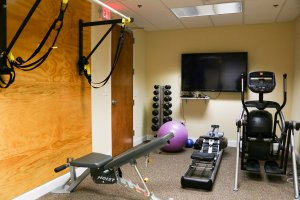 Aligning with W.M. Jordan Company’s commitment to health and wellness, our local office features a small gym where employees can sweat it out amidst their busy day. Wellness programs provide guidance and tools to help families maintain optimal health and balance work with their personal lives.
Aligning with W.M. Jordan Company’s commitment to health and wellness, our local office features a small gym where employees can sweat it out amidst their busy day. Wellness programs provide guidance and tools to help families maintain optimal health and balance work with their personal lives.
If you are unable to provide a fitness area or rollout a full wellness plan, think of smaller initiatives that may help harmonize the work-life balance and encourage personal development for your employees.
Consider Spatial Elements And Generational Preferences
Recognizing the values and work preferences of the next generation is imperative to attract top talent and develop future leaders. As a result, design principles have been re-imagined to support different types of interaction. Shifts in learning facilities, living environments, office spaces and mixed-use construction projects emphasize the blurred lines between learning, working and community.
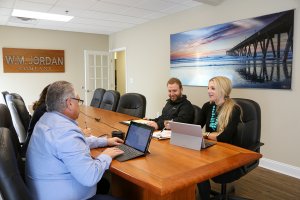 The movement towards more flexible workspaces offers a progressive approach to a multi-generational workforce with varying degrees of introversion and extroversion.
The movement towards more flexible workspaces offers a progressive approach to a multi-generational workforce with varying degrees of introversion and extroversion.
At W.M. Jordan Company, we strive to integrate shared spaces that encourage interaction and collaboration while considering the need for privacy and concentration. Non-structural options, such as portable acoustic walls, can be used to create spaces for individuals to work with maximum concentration or make calls.
Integrating informal breakaway areas with couches or soft seating is another flexible office trend worth considering. These alternative spaces allow employees to escape their screens in comfort, while also promoting socialization, idea sharing and a sense of belonging. Incorporating a central table or movable surface allows breakaway spaces to double as an informal meeting area or a place to enjoy lunch with others.
Although collaboration is an important part of the process, there is often a need to grind out work with minimal distractions or conduct business in a quiet environment. Seek to better understand your office’s unique dynamic and consider the individual needs of your employees to create spaces appropriately.
Shaped by two decades in the building industry and guided by the company’s mission to promote life-long learning and development, I am intrigued by the shifting landscape of office environments and its considerable effect on employee engagement. I believe company leaders who commit to improving the employee experience will see a positive impact on their business.
Rob Beale is Vice President at W. M. Jordan Company, leading the company’s efforts in the Carolinas region. W.M. Jordan Company provides construction management, design build, development, virtual construction, sustainability and contracting services to a diverse clientele. Rob opened the company’s Wilmington, NC office in 2012 with only five employees. Six years and two office expansions later, he has grown his staff to 34, with a regional revenue of $85 million in 2017. Rob started with W. M. Jordan Company in 1996 as the company’s first college intern. After earning a BS in Construction Management from Virginia Tech, his career at W.M. Jordan Company quickly accelerated, including nearly every aspect of construction service delivery. As a true believer in life-long learning, Rob continues to develop professionally and personally. He is currently completing an Executive Education Program for Leadership Development at Harvard University. Other past pursuits include the Disney Institute’s Leadership Excellence Program, FMI Construction Executive Institute’s Project Executive Course, and AGC of America’s Advanced Management Course. Rob is also on the Board of Directors for the Association of Builders and Contractors (ABC), Carolinas chapter and serves as a member of both the Board of Directors and the Fun Committee for Wilmington Downtown Inc. (WDI).



